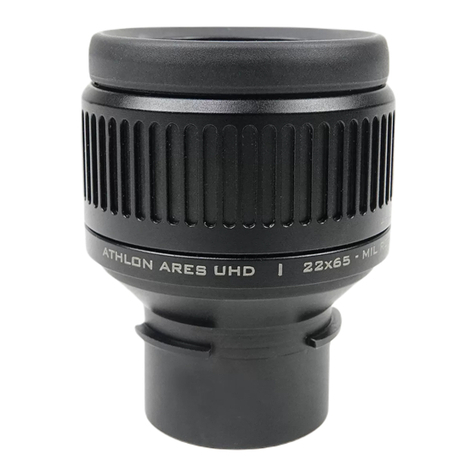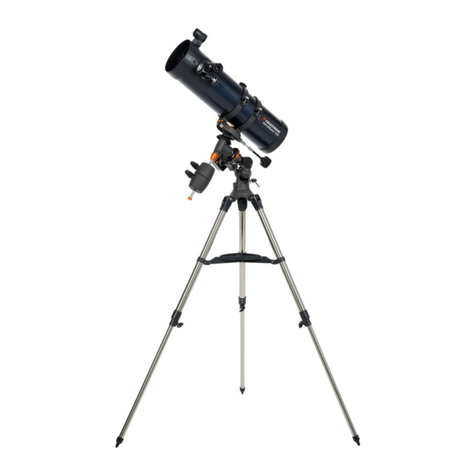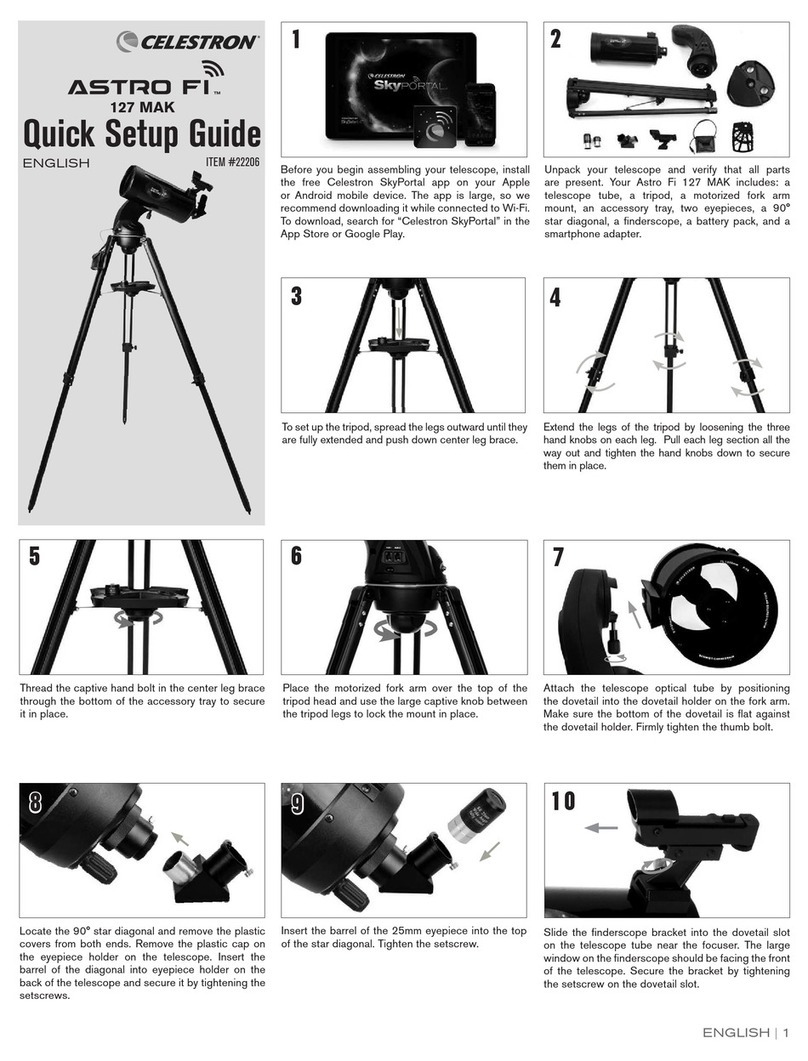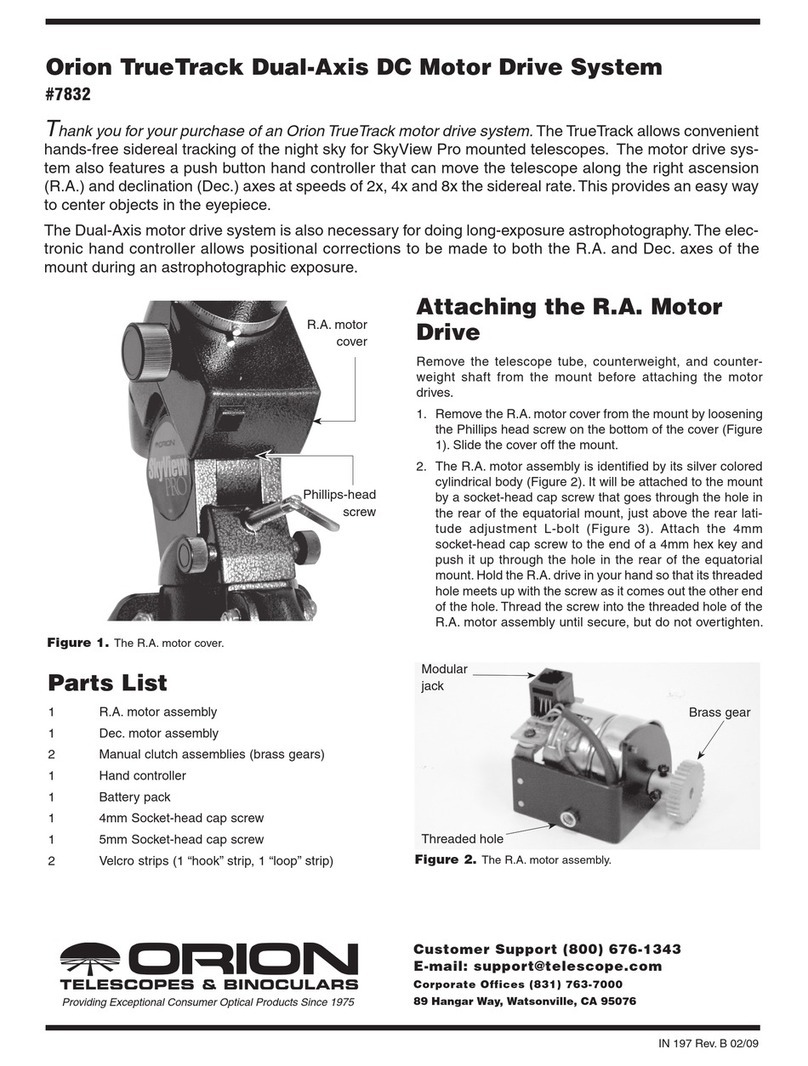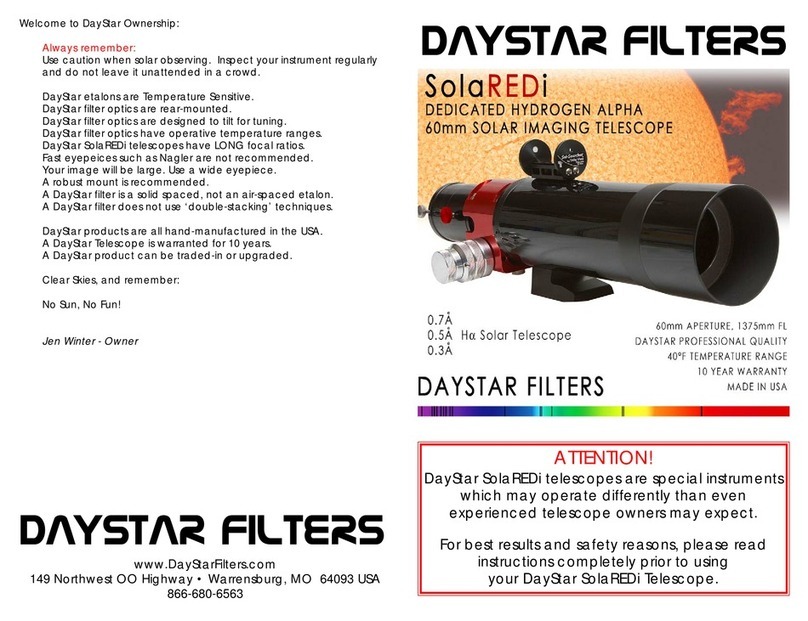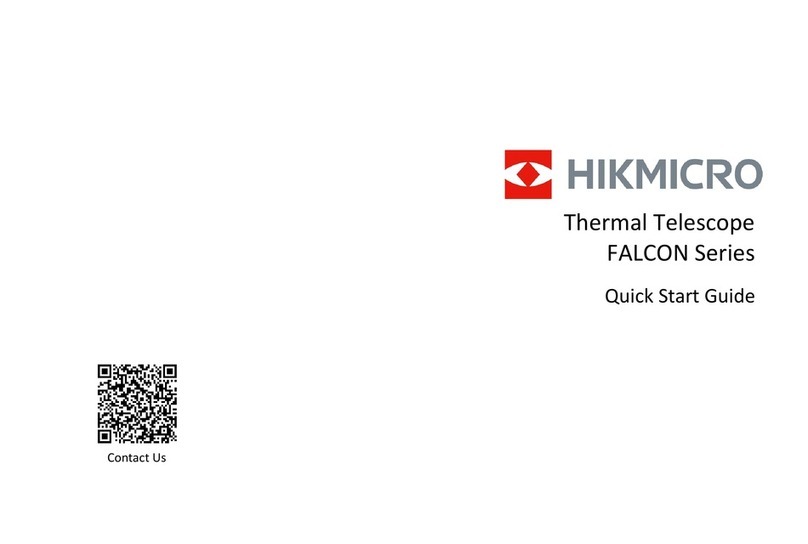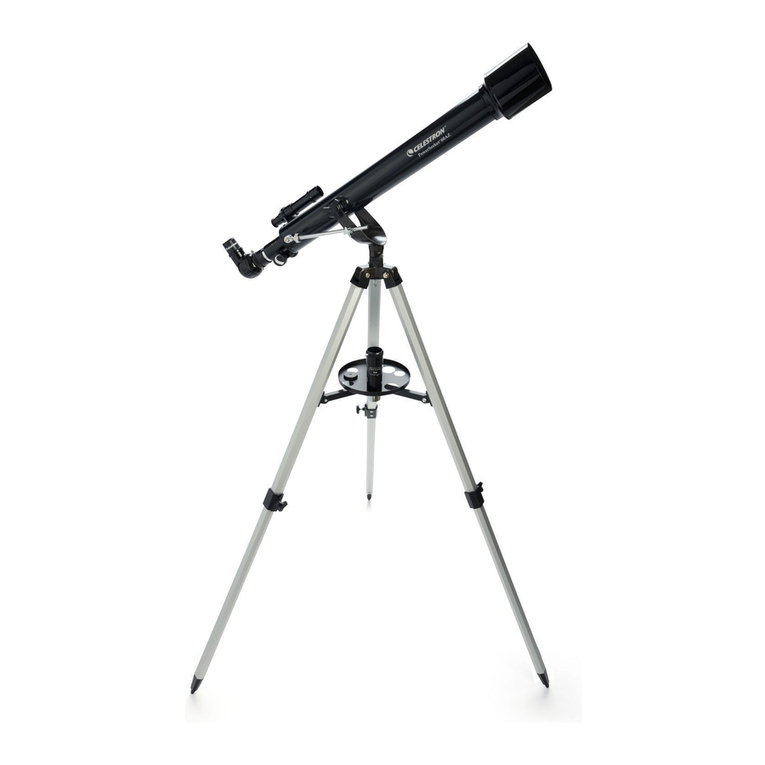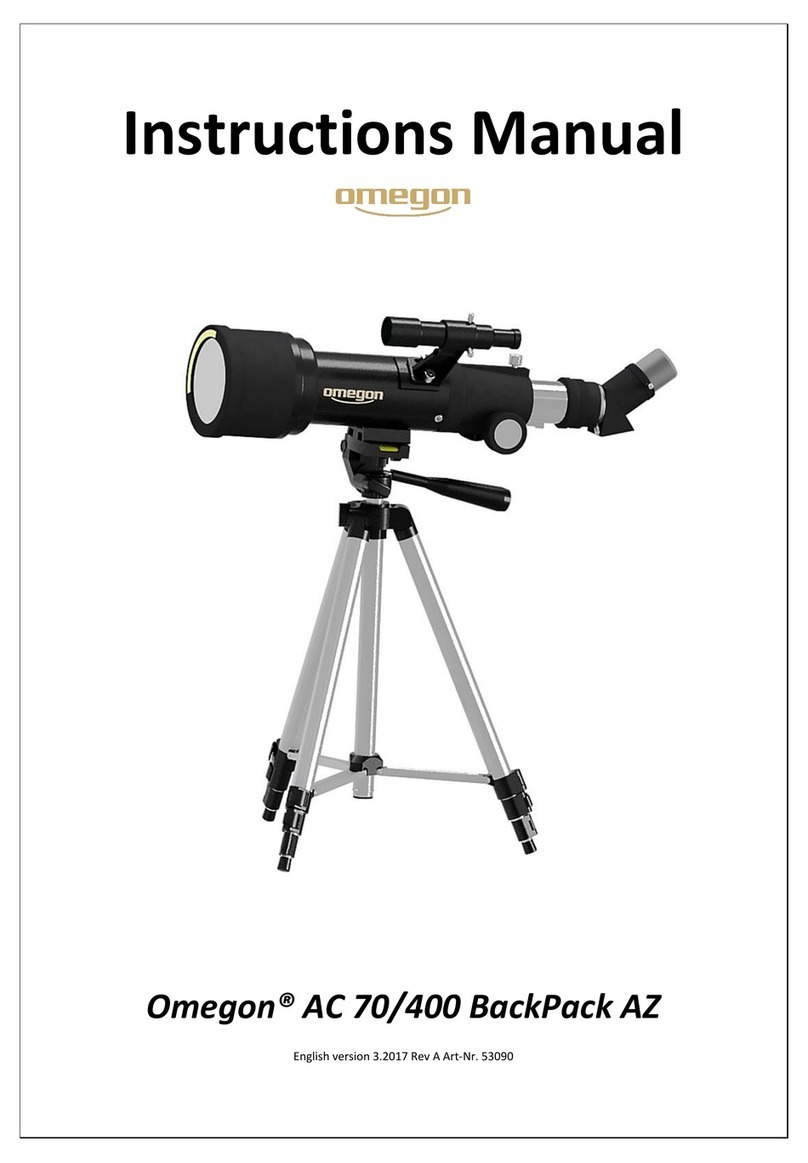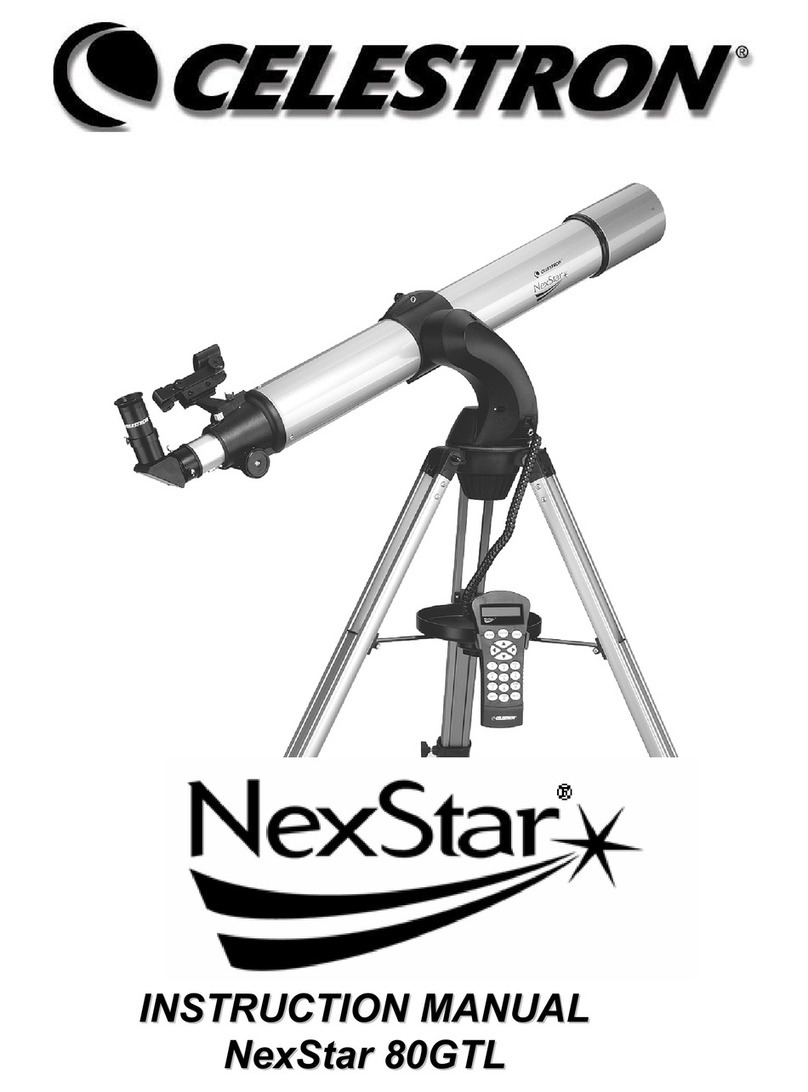TeleVue NP127is User manual

Company Seven
Astro-Optics Division
TELEVUE NP127is TELESCOPE
OPERATING GUIDE
2010 PRODUCTION MODEL
Above: NP127is telescope at Company Seven
Description/overview at: http://www.company7.com/televue/telescopes/tv127is_2010.html
Cover Photo: Copyright Company Seven
Showroom: 14300 Cherry Lane CourtCorrespondence: Box 2587
Laurel, Maryland 20707Montpelier, Maryland 20709-2587
301-953-2000[email protected]
http://www.company7.com
T1175 ManualOct 2010Page 1 of 11

1
32 Elkay Dr., Chester, New York 10918 (845) 469-4551. televue.com
TeleVue
®
Visionary
660mm f/5.2 IMAGING SYSTEM
4-ELEMENT APO REFRACTOR
Thank you for purchasing the Tele Vue-NP127is. It has been our pleasure to craft this fine instrument for you.
Nearly thirty years ago, Al Nagler received a U.S. patent for a fast, refracting telescope design based on
Josef Petzval’s portrait camera lens concept. Petzval’s design uses widely spaced doublets to produce a flat
focal plane over a relatively narrow field of view, just the sort of field a fast telescope can see. Nagler’s
combination of flat-field, fast focal ratio, and unobstructed system lent itself perfect for testing eyepieces.
The 5” f/4 MPT (Multi-Purpose Telescope) with its fast speed and wide, flat field, led to a series of
continuous improvements, primarily in color correction. The “Halley Commemorative,” 4” f/5.5 started
the parade where more advanced glasses including special dispersion, fluorite and fluorite substitute
glasses brought steady improvements. The 4” f/5 Genesis employed fluorite in the rear doublet, and the
subsequent SDF and Tele Vue-101 versions at f/5.4 brought us even closer to perfection. Maintaining
this fast f/5.4 speed while reducing tube length in a totally new design with new glasses allowed virtually
ideal color correction and improved field flatness in this, the ideal form culminating the 20 year refinement
toward perfection with the Nagler-Petzval 101, and NP127 with an even faster f/5.2 speed.
The Tele Vue-NP127is refines the original NP127 with the addition of a more robust, larger focuser
now standard with 10:1 reduction. The “is” designation denotes Imaging System, Tele Vue telescopes
with specific mechanical advantages for photography. Tele Vue offers a series of accessories in conjunc-
tion with each optical system so you are assured of compatibility and maximum performance. While the
NP127is maintains all the visual prowess of the previous NP127, the larger rear elements and larger
focuser along with a host of proprietary Imaging System accessories, make it ideally suited for the CCD
imager.
WARNING: NEVER try to look at the sun or point the telescope toward or near the sun without
professional solar observing equipment rigidly secured in front of the objective lens. When
observing the sun with the proper filters,
remove any sighting devices such as Star-
beam from the telescope. Use only the Tele Vue Sol
Searcher to find the sun. Instant and permanent eye
damage may result from viewing the sun directly, even
during a solar eclipse, or when viewing through thin
clouds, or when the sun is near the horizon.
Standard Features - Optical tube assembly includes:
captive sliding dew shield, 2.4” focuser with Focus-
mate 10:1 reduction, tilt adjustment end ring, screw-
on metal lens cover, 2” Accessory Adapter, Imaging
System Adapter, custom hard-shell case, Allen Keys
for end ring tilt adjustment.
TeleVue
-
®
2” Accessory Adapter (left)
Imaging System Adapter (right)
Lens Cap
Optical Tube Assembly
Case
Operating Guide

2
1.0 Getting Acquainted with the Tele Vue-NP127is
1.1 Optical tube assembly
The NP optical design contains four elements consisting of two widely spaced, air-spaced doublet groups.
The forward group of lenses are contained in a stainless steel lens cell. The cell attaches to the main tube
via three alignment screws. The front cell is encased within the sliding dew shield. The rear doublet, mak-
ing up the rest of the objective, is larger in diameter than the previous NP127 and provides additional
illumination at the edge of the field. This benefit is especially useful for large format CCD chips which
are extremely sensitive to light fall-off. The rear lens group is housed in the cell that threads between the
back of the tube and the focuser. Never stick any long objects into the focuser or you will hit the rear-most
lens surface.
1.2 Focuser
The 2.4” output side of the NP127is focuser is designed to pass all of the field rays exiting the rear ele-
ments of the objective, as the forward end of the draw tube has a 3” internal diameter. A larger focuser,
therefore, lends no additional illumination benefit.
The NP127is is shipped in its “visual” configuration. The 2” Accessory Adapter sits within the 2.4”
inside diameter of the drawtube. Four thumb
screws pass through both the drawtube and
adapter to cinch a brass clamp ring around
2” accessories. With four thumb screws there
is enough holding power for the heaviest of
visual accessories!
The two tension screws on the top of the
focuser body can be adjusted to add resis-
tance when using heavy equipment. These
tension screws tighten against a brass clamp
ring, which then cinches down on the Teflon
sleeve in which the draw tube slides. For
photography it is not necessary to tighten
beyond the need to keep a camera station-
ary but we do recommend to tighten them
in unison to avoid any focus shift. Note that
even when sufficiently tight, the focuser knobs
can still drive the draw tube.
The end ring can be adjusted (and locked)
to compensate for any tilt effects seen in CCD
imaging. Lock screws in the end of the draw
tube tighten against either the taper of the
10:1 Knob
1:1 Knob
Lock Screws
(typical)
Jack Screws (typical)
Jam Screws
(typical)
Digital Indicator
Mounting Points
1:1 Knob
Drawtube Tension
Screw (typical)
Focuser with 2” accessory adapter in place
2” Accessory
Adapter
127mm Front
Lenses and Cell
Dew Shield in
retracted position
Main Tube
Rear Lens Cell
Focuser Body
Draw Tube
End Ring
Focuser Pinion Assembly
Lock Knob
Draw Tube Tension
Fine Focus
Coarse Focus

3
Imaging System Adapter or brass clamp ring within the 2” Accessory Adapter. There are two configura-
tions for the lock screws: visual using four screws, and imaging using three screws.
The threaded holes on top of the focuser body accept the Digital Indicator Kit.
Operation of the rack and pinion focuser is via the 10:1 ratio Focusmate on the right side or either
of the 1:1 knobs. You might consider the optional Focusmate Driver for vibration-free focus control.
2.0 Mounting Options and Set Up
The telescope tube diameter is 5”. The dual ring MRS-5000
is suited for photography and CCD imaging with a variety
of adapter plates that can be bolted to the base plate.
The base plate also bolts to the Tele Vue Gibraltar5 Alt-Az
mount if a more travel-friendly, visual use mount is desired.
Each tube ring has two machined channels with #10-32
threaded holes for mounting accessories. A central bar
spans across the top of the two rings for added stability.
The bottom of the tube rings have ¼-20 holes to accept
mounting studs or screws. Telescope balance is achieved
by unlocking the “bat handle” screws and sliding the tube
fore or aft. Once the O.T.A. is repositioned, retighten the
bat handle screws.
3.0 Visual Observing Set Up
As previously mentioned, the NP127is is shipped in its “visual” configuration. If you have removed the
2” Accessory Adapter and would like to re-install it, loosen the four end ring lock screws sufficiently to
remove any accessory that may be in place. However, do not retract them fully into the end ring. By
allowing them to protrude into the body (note photo below), they act as locators. Looking at the 2” Ac-
cessory Adapter, note the four grooves with holes machined 90° apart. The grooves help index the holes
in the adapter to the four thumb screw arrangement in the end ring. This will ease installation in the dark.
Insert the 2” Accessory Adapter into the end of
the focuser. If it does not go all the way in,
rotate the adapter. When the grooves in the
adapter align with the protruding screws, the
adapter will seat fully into the focuser. Tighten
the four screws a few turns so they enter the
holes in the adapter. The lock screws will
now act against the brass clamp ring in the
2” Accessory Adapter.
Slip a Tele Vue 2” Everbrite diagonal into
the focuser and tighten the lock screws. You
will now be able to reach focus with any Tele
Vue eyepiece.
IMPORTANT CAUTION: When replacing
the orange plastic plug into the 2” Accessory
Adapter, push it in far enough to seat. Do not
use the lock screws to clamp the plug in place
as the clamp screws will distort the brass clamp
ring in the 2” accessory adapter.
3.1 Eyepieces
With its wide, highly corrected, flat field and fast f/ratio, the NP127is puts eyepieces to the test. This
scope demonstrates the superiority of Tele Vue eyepiece performance and, with a range of 12x to 330x
(if the atmosphere allows) there is a magnification for all purposes. See chart at the end of this manual or
MRS-5000
Focuser set to accept 2” Accessory Adapter
Lock Screws threaded
partially in to use as
guides for inserting
the 2” Accessory
Adapter

4
call Tele Vue for recommendations. In general, we suggest choosing low and medium power eyepieces
in ratios of field stop diameters. For example, factors of 1.4 or 2.0. When choosing higher power eye-
pieces, use ratios of magnification. (See reference chart in the “Choosing Your Eyepieces” article.)
3.2 Finders
We particularly recommend using the Starbeam reflex sight (part# SFT-2003), which attaches to the Tube
Rings. The case has a cutout for the Starbeam. The Quick Release Universal Finder Bracket (QFM-1008)
can hold a traditional 50mm finderscope and also attaches to the mount ring channels.
4.0 Photographic Set Up and the Tele Vue Imaging System
Tele Vue Imaging System Accessories provide solid threaded connections between components. To use
these accessories requires the insertion of the Imaging System Adapter (ISA) into the focuser. You will find
the ISA in the accessory compartment in the lid of the telescopes case. To install the ISA, first back off the
four Lock Screws far enough to pull the 2” Accessory Adapter out from the drawtube to reveal the 2.4”
diameter. Store the adapter in the accessory compartment in the case. You will then need to back out
the screws further so their ends are flush
with the inside diameter of the End Ring.
We have found that three point sus-
pension is best to hold the ISA flat and
firm against the end ring. This will require
you to remove the two button-head Allen
screws from the end ring with the supplied
Allen key. These button-head screws are
found below (to the left of) the upper-left
and lower-right Lock Screws. Move the
two nearest Lock Screws into these newly
revealed holes. You may remove the
lower-left Lock Screw or simply leave it
in place so it is not lost. Make sure all
screws are backed out enough so that
they do not protrude into the focuser.
Insert the ISA and tighten the three
Lock Screws located at 1:00, 5:30, and
9:30 (if you imagine the end of drawtube
as the face of a clock).
The Imaging System’s threaded
accessories provide a variety of options
for camera adaptation and focal length
variation. The goal of Tele Vue’s Imaging
System is to let you pursue your astropho-
tographic passion with ease, by providing
accessories designed to work together.
The following summary of parts and picto-
rial diagram will help you understand each
part’s use and its sequence in the chain.
Please note that spacing requirements of
any particular camera will need to be
met by the appropriate Imaging System
spacer or combination of spacers.
Conversion from visual (top) to imaging (bottom) con-
figurations. Remove Button Head screws with supplied
Allen key. Move the two closest Lock Screws into the
open holes. Remove 4th, unused Lock Screw.
Remove Button
Head Screw
Remove Button
Head Screw Replace button head
with Lock Screw
Replace button
head with Lock Screw
3-Point Lock Screw arrangement for imaging.
End Ring
2” Accessory
Adapter
Imaging System
Accessory Adapter

5
Focuser Features
A. Large Focuser features include:
•Drawtube with 3” entrance aperture, 2.4” exit aperture
•End-ring with tilt capability
•4-Lock knobs to secure 2” Accessory Adapter, 3-Lock
knobs alternate for photography
•Body has brass clamp ring with 2 lock knobs
•Focusmate 10:1 dual speed focuser
•Indexed 2” accessory adapter with brass clamp ring
•Imaging insert threaded for imaging system components.
Accessories (optional)
B. LMK-2404/LMF-2405 Digital Indicator Kits for
Large Focuser
C. DSF-8002 2” Everbrite Star Diagonal
D. FDF-2004 Focusmate Driver electronic vari-speed
motor control.
E. LCL-1069 Large Field Corrector for optimized edge
performance.
F. NPR-1073 0.8X reducer
G.AFT-1105 48mm Filter adapter
H. AD2-1110 Apogee U47 D2/Yankee Robotic
adpter
I. AD7-1111 Apogee U9000/U16 D7/D9
adapter
J. STL-1071 SBIG STL series adapter
K. TRG-1072 Standard T-Ring adapter
L. CWT-2070 Canon Wide T adapter
M.A2A-1107 2” Accessory adapter
N.TLX-1108 SCT Type Threaded Filter Housing
adapter
O.TLA-0250 0.25” long threaded extension
P. TLB-0375 0.375” long threaded extension
Q.TLC-0500 0.500” long threaded extension
R. TLD-1000 1.000” long threaded extension
S. NPE-1118 1.5x Extender for NP101is and
NP127is
LCL-1069 Large Field Corrector
• Optimizes edge of eld performance. Recommended for 35mm CCDs (43mm diagonal) and larger.
NPR-1073 – 0.8x Reducer for NP and NPis series telescopes
• Recommended for increasing eld with APS size formats (27mm diagonal)
• Constructed to t both standard 2” focuser NP scopes (RAD-1074 required) and the threaded “NPis”
accessories on the input end. Requires either CWT-2070, STL-1071, or TRG-1072 to connect to camera.
NPE-1118 1.5x Extender for NP127is
• Increases focal length to 990mm.
STL-1071 – SBIG STL series camera adapter
• This adapter is sized to thread directly onto the STL series cameras and mates with Imaging System
accessories.

6
TRG-1072 – Standard T-ring adapter
• This is the most restrictive of adapters as it has the smallest inside diameter. Recommended for use
with APS size or smaller chips.
CWT-2070 – Canon Wide T Adapter
• Adapts Imaging System Accessories to Canon DSLRs. Includes Canon Bayonette mount.
• Eliminates the inner portion of Canon T-rings to provide a larger diameter opening for reduced vignetting.
AD2-1110 – Apogee U47-D2 Camera Adapter
AD7-1111 – Apogee U9000/U16-D7/9 Adapter
A2A-1107 – 2” Accessory Adapter
• Use for cameras with 2” nosepiece or any other 2” accessory. (Extension tubes may be required to
reach focus.)
• Dual thumb-screws and clamp ring for positive locking.
TLX-1108 – SCT Type Thread for filter wheel housings such as the True Technology Custom Wheel
AFT-1105 –48mm Filter adapter
• Allows use of 48mm lters in the system.
• Best if used closest to the chip to minimize any vignetting
• Adds 0.25” of spacing.
TLA-0250 – 0.250” (6.4mm) Extension Tube
TLB-0375 – 0.375” (9.5mm) Extension Tube
TLC-0500 – 0.500” (12.7mm) Extension Tube
TLD-1000 – 1.000” (25.4mm) Extension Tube
TLF-0040 – 0.040” (1.0mm) Spacer
TLG-0080 – 0.080” (2.0mm) Spacer
TLS-1121 – Set of TLF-0040 and TLG-0080.
TLS-2245 – Set of all six.
• Threaded coupling provides the necessary distance for proper spacing of eld lenses to chip.
Required spacers will vary depending on camera specifications.
• Black anodized aluminum with anti-reection threads for maximum contrast.
sucoFemirPtaecnamrofrePpoTrofsnoitadnemmoceRtnenopmoC
dednemmoceR
mumixaM
mlif/DCC
lanogaid
deepShtgneLlacoFweiVfodleiF aremaC
rotcennoC
lanoitiddA
hctamotrecaps
mm55
ecnerefer
sneLyrosseccA
htgnelrecapS
resucofmorf
ebutward
1mm03 )ezisSPA( 2.5/fmm066°6.2
gnir-T )2701-GRT( ro gniR-TediW )0702-TWC(
XX "573.2 0001-DLT)2( 5730-BLT)1(
2mm03 )ezisSPA( 2.4/fmm825°2.3
gnir-T )2701-GRT( ro gniR-TediW )0702-TWC(
XrecudeRx8.0 )3701-RPN( "5.0 0050-CLT
3m
m04 seiresLTSGIBS( )saremac 2.5/fmm066 seireSLTSGIBS )1701-LTS(
"578.0 0050-CLT)1( 5730BLT)1(
dleiFegraL rotcerroC )9601-LCL(
"5.1 0001-DLT)1( 0050-CLT)1(
4
eegopA htiwsaremaC sdiL7Dro2D 2.5/fmm066 htiwyravlliW aremac 0111-2DA 1111-7DA
"052.1 0001-DLT)1( 0520-ALT)1(
dleiFegraL rotcerroC )9601-LCL(
"573.1 0001-DLT)1( 5730-BLT)1(
5mm04 )mliFmm53( 2.5/fmm066°5.3
gnir-T )2701-GRT( ro gniR-TediW )0702-TWC(
"52.0 0520-ALT
dleiFegraL rotcerroC )9601-LC
L(
"5.1 0001-DLT)1( 0050-CLT)1(
htiwyravlliW aremac

7
4.1 Adjustable Position End Ring
The tilt of the End Ring to the optical axis can be changed to compensate for any tilt errors you may see in
your photography. The telescope is aligned with the End Ring locked firmly against the end of the draw
tube. In this way you are always assured of a reference point to return to if necessary.
To determine which way to tilt the End Ring, it is necessary to focus on the part of the image that comes
to focus first when racking out the focuser from its “in” position. That will permit adjusting, or “jacking,”
the End Ring “out” to match that focus point in the field.
You will need to remove your camera equipment, including the Imaging System Adapter to adjust the
tilt of the End Ring . Slightly loosen the three Jamb Screws located on the face of the End Ring with the
appropriate Allen key. Then, “jack” the End Ring to the desired position using the appropriate Allen key
Jack Screws. Tighten the Jamb Screws against the End Ring and reinstall your camera. Some trial and
error imaging will be necessary, so it is best to carry out any necessary adjustment during an imaging
session.
4.2 Prime Focus
Prime focus photography involves attaching a camera, without its lens, to the telescope. In this method
the telescope becomes the camera’s lens. In the case of the NP127is, it is a 660mm focal length, f/5.2
telephoto. It is the focal length of the telescope in combination with the diagonal dimension of the CCD
chip or film frame that will determine the amount of field your photograph will cover. The shorter the focal
length or larger the diagonal dimension, the greater the field that will be recorded.
The parts necessary for Prime Focus photography are: camera with T-ring, appropriate T-ring adapter,
Extension Spacers, Imaging System adapter, telescope.
To obtain the best edge sharpness with CCD chips 30mm or larger, use the Large Field Corrector
(LCL-1069) in the configuration listed on page 6.
The recommendations in the chart and diagrams are specifically for SLR (digital or film), Apogee and
SBIG STL series cameras. If you have a different camera, you will need to determine the spacing necessary
to achieve reference distance from the seat of the Large Field Corrector to the CCD chip. These spacers
will be added between the seat of the Large Field Corrector and the face of your camera. Check the Tele
Vue website for on-going camera updates.
To start, you need to know the distance from the chip to the faceplate of the camera. This should
be specified in the camera’s documentation; call your camera’s manufacturer if it is not. The equation is
simply 2.6” — Chip to faceplate distance = additional spacer length required. There is enough tolerance
in this value that using threaded Imaging System extension tubes along with 0.040” and 0.080” spacers
to bring you as close as possible will work fine.
4.2a) To gain more field with chips APS size and smaller, use the 0.8x Reducer (NPR-1073). While the
reducer can be used with larger formats, noticeable vignetting will occur. The standard technique of “flat
fielding” should compensate. The arrangement of parts necessary for Prime Focus photography with the
0.8x Reducer is: camera with T-ring, appropriate T-ring adapter, NPR-1073, Extension Spacers to mini-
mize draw tube out-travel, Imaging System adapter, telescope. The equation to figure the proper spacing
between the 0.8X Reducer and the CCD chip is: 2.44” — Chip to faceplate distance = additional spacer
length required.
4.2b) To gain more magnification, the 2x (PMT-2200) and 4x (PMT-4201) Powermates are recommended
for best performance. Start by inserting the 2” Accessory Adapter into the end of the focuser. (Since increas-
ing the magnification will reduce the field, the large opening provided by the Imaging System Adapter is
of no benefit.) The arrangement of parts necessary is: camera with a T-ring attached, Powermate with cor-
responding T-ring adapter (PTR-2200 or PTR-4201) attached, 3.5” Extension Tube (X3C-0009), telescope.
There are certainly a variety of ways of setting up the Tele Vue-NP127is for photography!

8
5.0 Imaging System Focus Accessories
5.1 All Tele Vue telescopes with rack and pinion focusers
now permit the photographer to index focus position to
within 0.0005” by means of a digital indicator. Mount-
ing points are provided on top of the focuser body and
end of the draw tube for easy installation of the various
Digital Indicator Kits. Using the Digital Indicator provides
a convenient way of finding best focus, returning to it,
or checking that it hasn’t changed.
Choose either the 10 Micron (0.0004”) Indicator
Kit (LMK-2404) or the 1 micron Indicator Kit (LMF-2405)
depending on the accuracy desired. Both indicators
have 0.5” motion ranges and accept an RS-232 output
cable for displaying readout on computer. The 10 foot
long RS-232 Output Cable (RSC-2320) permits remote
indicator readout on computer screen via downloadable
software from the Tele Vue website (www.TeleVue.com). The cable also provides power to the indicator.
5.2 The Focusmate Driver for the NP127is (FDF-2004) electronically drives the fine focus knob of the
Focusmate in steps of approximately 0.0005” per button click. With the button depressed, the motor
drives the Focusmate continuously without vibration transferred to the system. Motor speed is variable.
The motor has a standard phone jack that will accept a cord of any length. Remote control is possible.
Contact Tele Vue for further details.
5.3 The Tele Vue Imaging System comes full circle when you add the Focusmaster (FMU-2319) to your
system. The Focusmaster is the communication gate way for the Digital Indicator Kit and the Focusmate
Driver to become a “closed-loop” focusing system with your camera and camera control software. Con-
verge focus quickly on the base of the “V” curve to within a micron when using our 1-micron indicator...
you just can’t do this by hand!
6.0 Caring for your NP127is
The Tele Vue-NP127is requires no special care. Treat it as you would any fine camera lens. Use the lens
cap when the telescope is being stored or not in use. The captive dew shield provides protection from glare,
helps protect the lens from dust or spray blown in by the wind and minimizes dew formation on the lens.
If dew forms on the lens during cold weather, it is best to use a hair dryer (on the lowest setting) to
gently warm it away. A few specks of dust will have no effect on image quality and may be gently blown
off with a squeeze bulb. Do not use compressed air cans to blow dust off optical surfaces.
Fingerprints, however should be cleaned off. Though the anti-reflection coatings are durable, they are
easily scratched. The simplest cleaning method is to moisten (not soak) a very soft, lint-free tissue, cloth,
“Q-Tip” or surgical cotton with a lens or glass cleaner and gently whisk away the stain. Do not apply
any solutions directly to the glass surfaces. After every cleaning stroke, use a fresh applicator. The fewer
strokes the better! Any residual “film” will not affect visual performance.
Collimation of your Tele Vue-NP127is has been locked at the factory. With reasonable care it will
remain aligned. However, rough handling can cause misalignment. WARNING: Do not loosen the but-
ton head screws in the front or rear lens cells as this will cause misalignment. If necessary, contact Tele
Vue for re-collimation.
The tube is powder-coated for durability and requires no special care. Black anodized surfaces can
be cleaned with Windex. If you have any questions about the care, operation or performance of your
Tele Vue-NP127is, please call us at (845) 469-4551 from 9:30 am to 5:00 pm EST.

9
7.0 Warranty
Tele Vue telescopes are warranted to be free of manufacturing or workmanship defects for 5 (five) years
from the date of purchase, to the original owner. Please return the warranty card as validation of your
ownership and for easy identification. If your Tele Vue telescope requires warranty service, please call
Tele Vue to discuss the problem, upon which you will receive a return authorization. NO RETURNS ARE
ACCEPTED WITHOUT PRIOR AUTHORIZATION.
The warranty does NOT include: collimation, defects caused by mishandling, defects of subjective
nature, or coverage for any telescope purchased through an unauthorized Tele Vue dealer.
Warranty work will be performed at Tele Vue’s discretion and may only be performed by Tele Vue
Optics. The telescope must be shipped in its case with proper inner and outer packaging. Return shipping
and insurance charges are the purchaser’s responsibility.
8.0 Specifications
Type 4-element, flat field, APO refractor, Fully Multi-Coated
Clear Aperture 5 inches (127mm)
Aperture Gain 329, compared to a 7mm exit pupil
Focal Length 660mm
Focal Ratio f/5.2
Resolution (visual) 0.9 arc-sec. (Dawes Limit for a 5 inch aperture)
Resolution 277 line pairs per mm
(photographic)
Magnification 12x to 330x using Tele Vue eyepieces
Field, Visual 4oat 12x (55Pl) or 16x (41Pan)
Focuser 2.4-inch, rack and pinion type
Diagonal Optional 2-inch 99% reflective dielectric coating, with 1¼” adapter
Finder Optional Starbeam, Quick-Release Finder Bracket (50mm Finderscope not included), or
low power eyepiece.
Mounting Optional adjustable mount ring set with mounting plate for Gibraltar5 Mount
Weight 14.6 lbs. (tube assembly) 28 lbs. in case, 32 lbs. shipping
Length 33-inches (O.T.A. only)
Accessories included as standard: custom fitted case, screw-on lens cover, sliding dew (glare) shield,
2” Accessory Adapter, Imaging Systems Adapter
Tube Powder-coated aluminum
Specifications subject to change without notice.

10
si721PN-euVeleT
sdleiFeurTediwrofseceipeyE"2
lacoF
htgneL
)mm(
epyTedoCtcudorP tnerappA
)°(dleiF
potSdleiF
)mm(.aiD
feileReyE
)mm(
thgieW
.bl .gaM
eurT
dleiF
).ged(
tixE
lipuP
)mm(
fo#
.melE
xrtpoiD
ydaeR
55lssolP0.55-LPE050.64833.10.210.46.014Y
14citponaP0.14-OPE860.64721.21.610.49.76Y
135epyTrelgaN0.13-5NE280.24912.23.126.30.66Y
53citponaP0.53-OPE867.83426.19.814.37.66Y
12sohtE0.12-HTE0012.63513.24.131.30.4-Y
625epyTrelgaN0.62-5NE860.53615.14.520.30.56Y
224epyTrelgaN0.22-4NE281.13915.10.037.22.
47Y
72citponaP0.72-OPE865.03911.14.426.22.56Y
71sohtE0.71-HTE0016.92516.18.836.23.3-Y
025epyTrelgaN0.02-5NE284.72210.10.334.28.38*Y
714epyTrelgaN0.71-4NE283.42716.18.831.23.37Y
sdleiFeurTediwrofseceipeyE"¼1
04lssolP0.04-LPE340.72824.05.613.27.74Y
23lssolP0.23-LPE050.72224.06.023.22.64Y
42citponaP0.42-OPE860.72515.05.723.26.46*Y
31sohtE0.31-HTE0013.22512.18.059.15.2-Y
615epyTrelgaN0.61-5NE281.22014.03.149.11.36N
91citponaP0.91-OPE863.12314.07.438.17.36*Y
52lssolP0.52-PAE052.12713.04.628.18.44N
81naidaR0.81-DRE063.81025.07.636.15.36Y
01sohtE0.01-HTE0017.71511.10.665.19.1-Y
316epyTrelgaN0.31-6NE286.71215.08.055.15.27*Y
02lssolP0.02-PAE051.71412.00.335.18.34N
214epyTrelgaN0.21-4NE281.71711.10.555.13.26Y
srewoPmuideMrofseceipeyE"¼1
116epyTrelgaN0.11-6NE289.41214.00.063.11.27 *Y
41naidaR0.41-DRE064.41025.01.743.17.26Y
51lssolP0.51-PAE056.21012.00.441.19.24N
96epyTrelgaN0.90-6NE284.21214.03.371.17.17*Y
11lssolP0.11-PAE051.981.00.068.01.24N
srewoPrehgiHrofseceipeyE"¼1
8sohtE0.80-HTE0019.31510.15.282.15.1-Y
6sohtE0.60-HTE0014.01510.10.0119.02.1-Y
76epyTrelgaN0.70-6NE287.9215.03.498.03.17 *Y
8naidaR0.80-DRE063.8026.05.287.05.16Y
7.3sohtE7.30-HTE0010.7511.14.8716.07.0-Y
56epyTrelgaN0.50-6NE280.7215.00.2316.00.17 *Y
8lssolP0.80-PAE055.661.05.286.05.14N
6naidaR0.60-DRE063.6028.00.0115.02.17Y
5naidaR0.50-DRE063.5028.00.2315.00.17Y
5.36epyTrelgaN5.30-6NE288.4215.06.8817.07.07*Y
4naidaR0.40-DRE062.4028.00.5614.08.07Y
5.26epyTrelgaN5.20-6NE284.3215.00.4623.05.07*Y
3naidaR0.30
-DRE063.3028.00.0223.06.07Y
srewoPhgiHdnamuideMrofeceipeyEmooZ"¼1
6tA mooZrelgaN6030-ZNE051.5 013.0 0114.02.1 5N
3tA6.20222.06.0
4tA mooZrelgaN4020-ZNE055.2 014.0 5612.08.0 5N
2tA3.10331.04.0
deriuqerretpadAxrtpoiDlanoitiddasetacidnI*°3.75X)htgneLlacoFepocseleT/.aidpotSdleiF(=seergednidleiFeurT:ETON
Other manuals for NP127is
2
Table of contents
Other TeleVue Telescope manuals
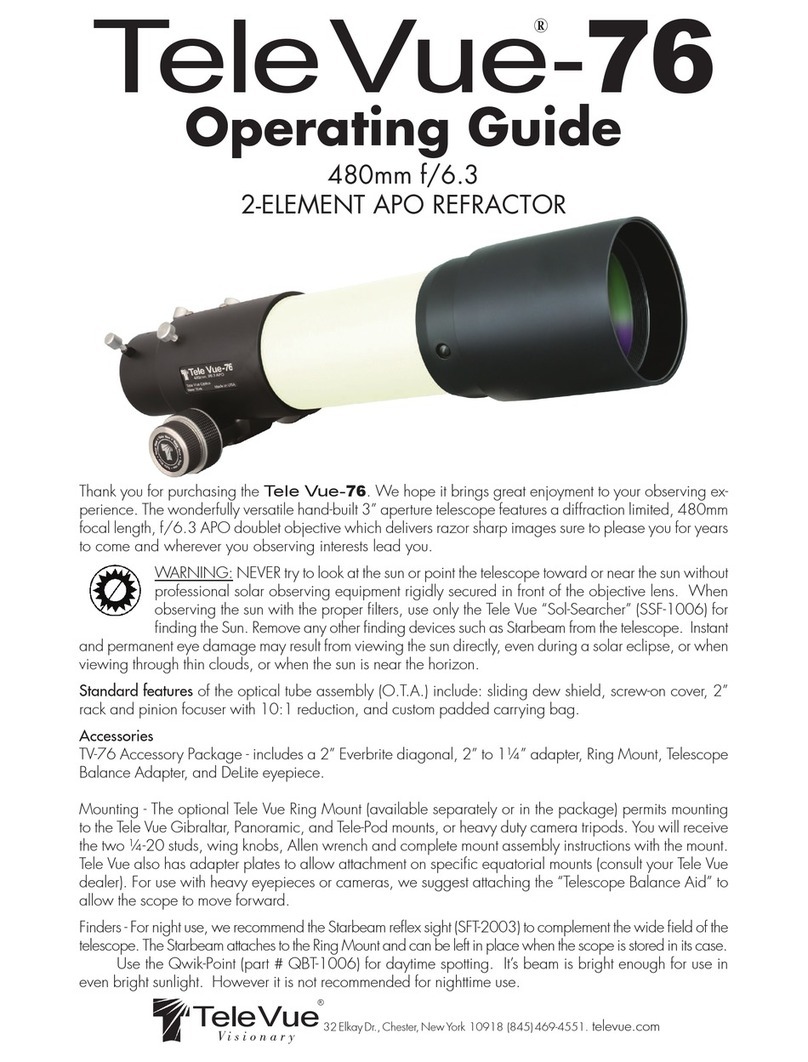
TeleVue
TeleVue 76 User manual
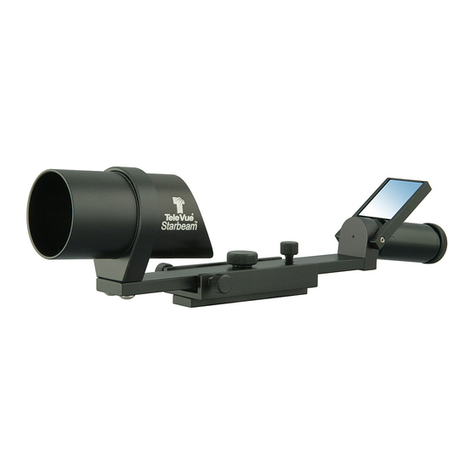
TeleVue
TeleVue Starbeam SFT-2003 User manual
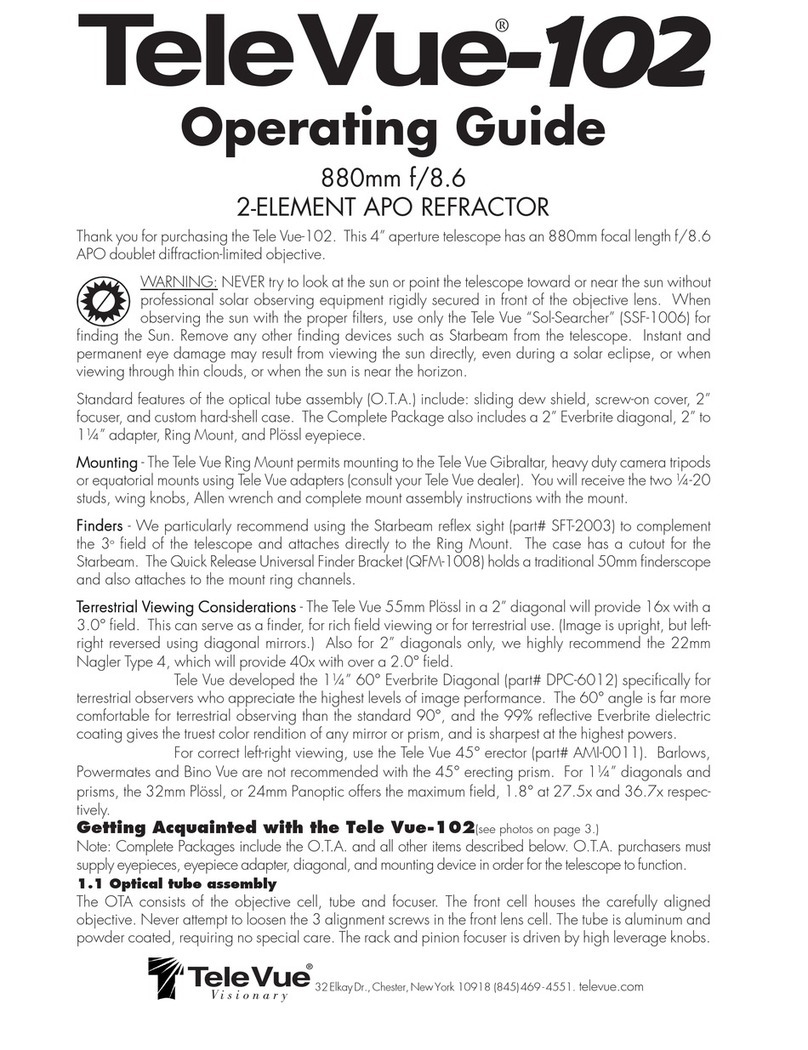
TeleVue
TeleVue 102 User manual
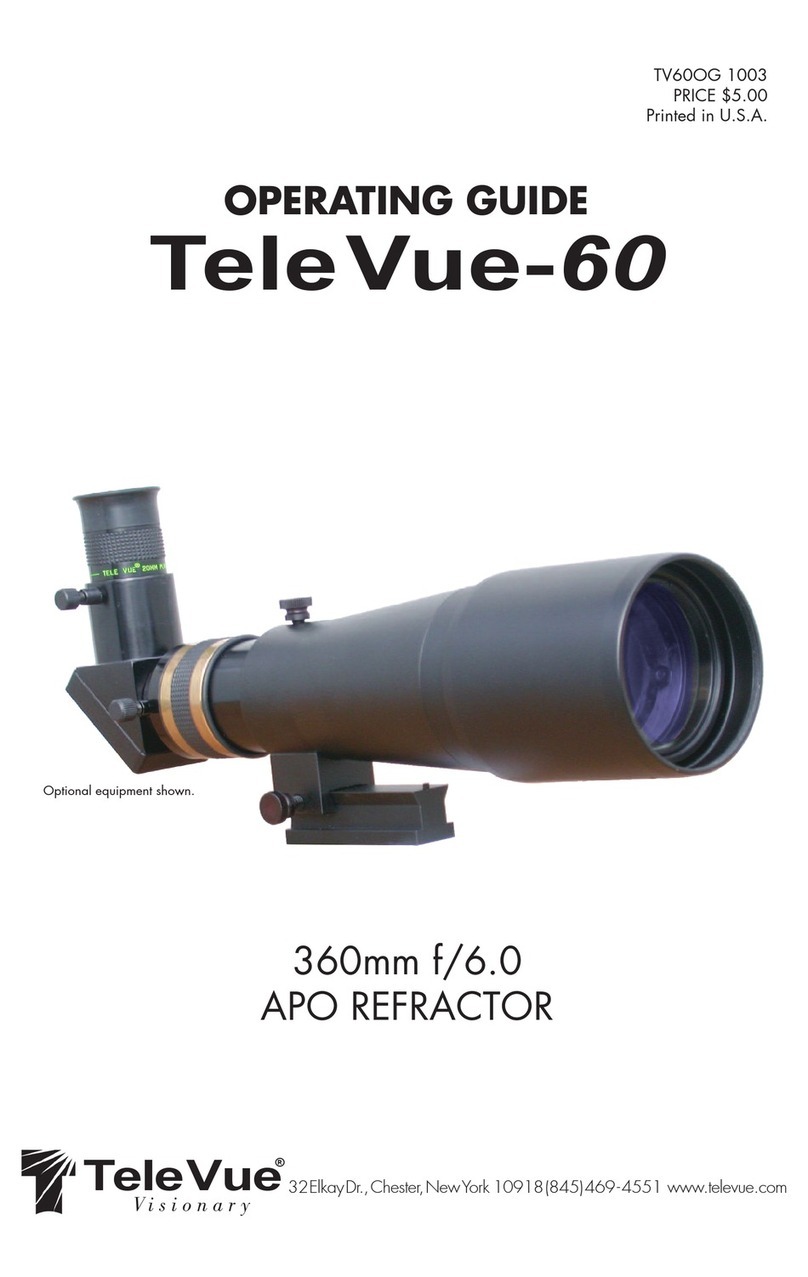
TeleVue
TeleVue 60 User manual
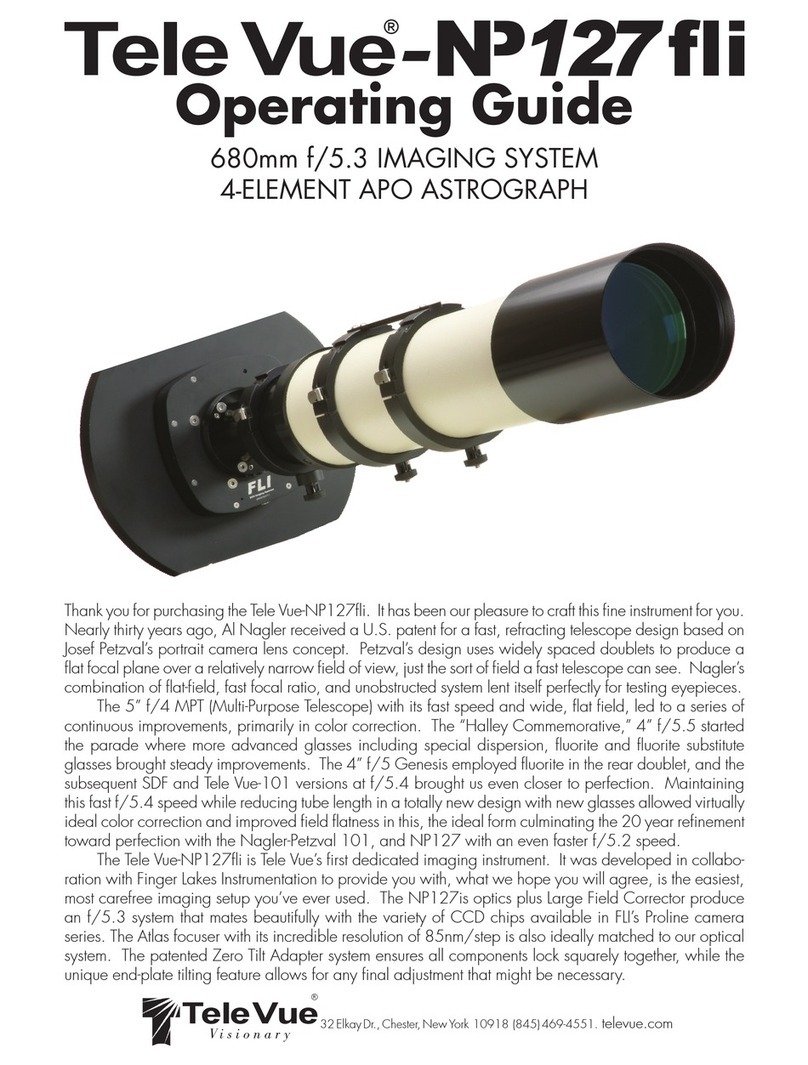
TeleVue
TeleVue Tele Vue-NP127fli User manual
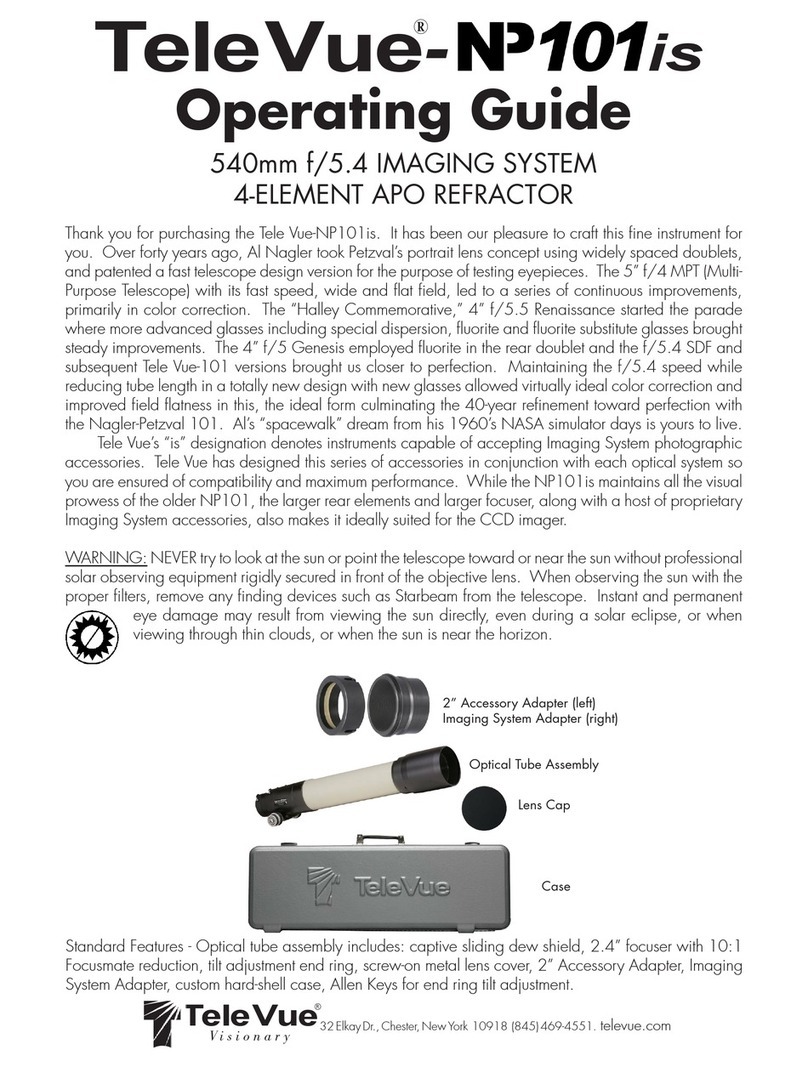
TeleVue
TeleVue NP101is User manual

TeleVue
TeleVue NP101is User manual
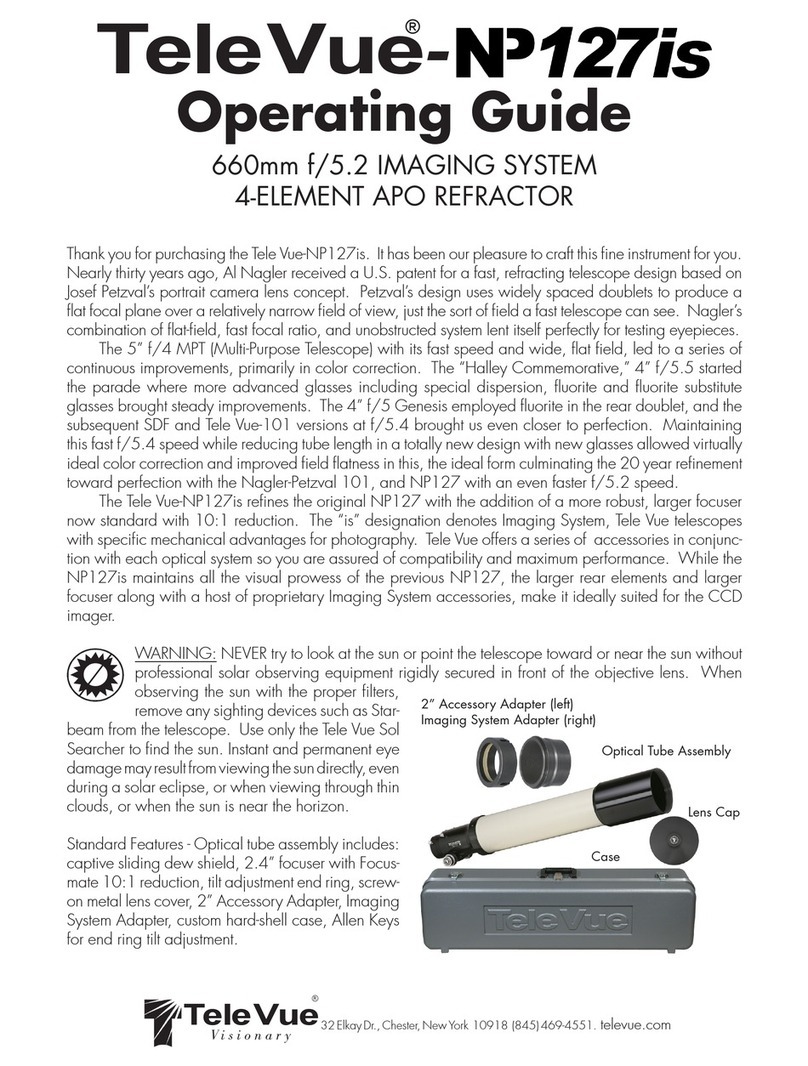
TeleVue
TeleVue NP127is User manual
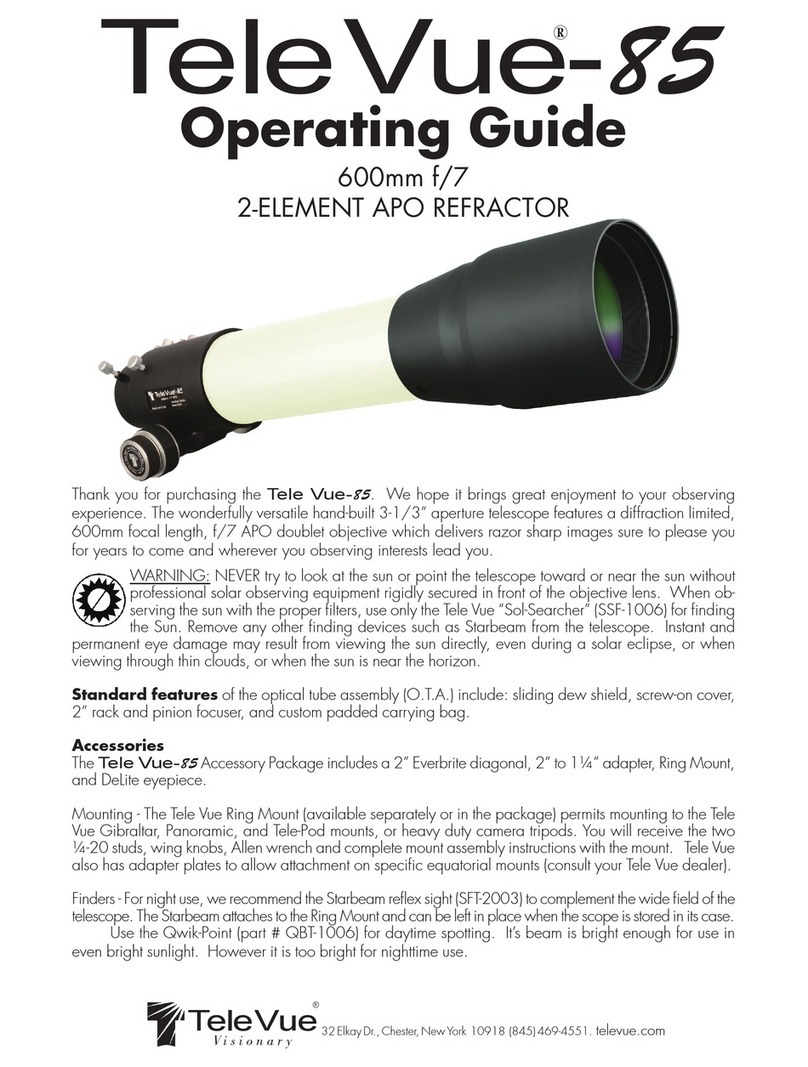
TeleVue
TeleVue 85 User manual

TeleVue
TeleVue NP127is User manual
Popular Telescope manuals by other brands
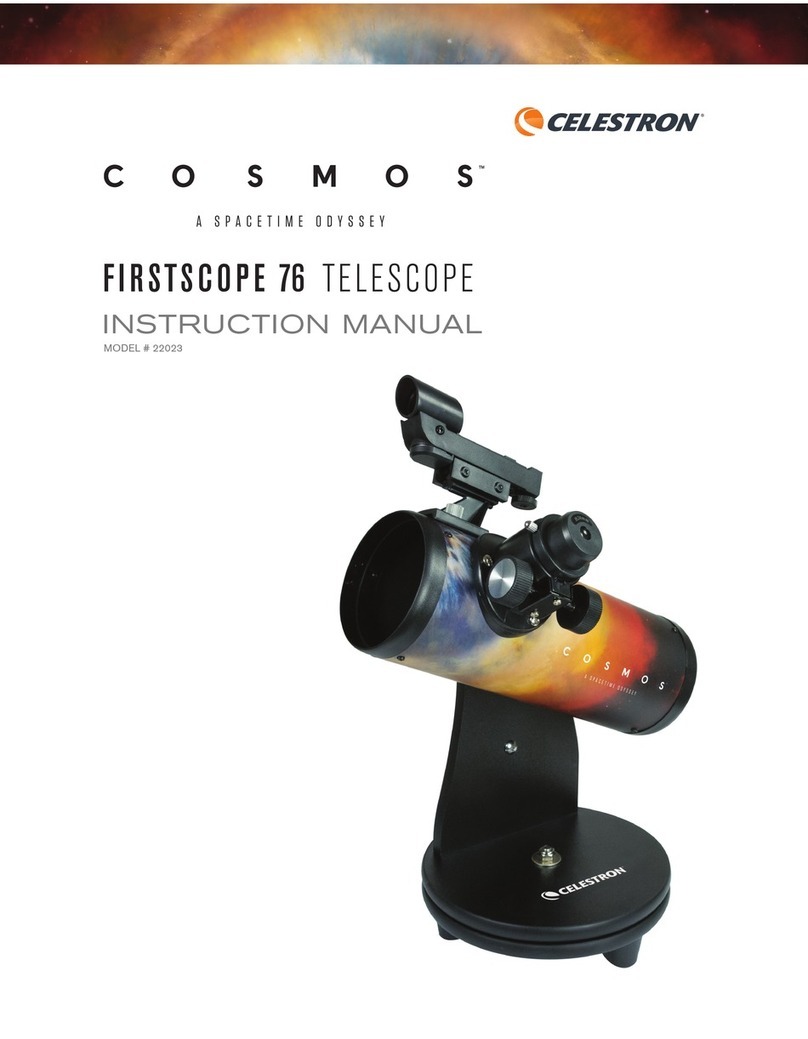
Celestron
Celestron FirstScope 76 instruction manual
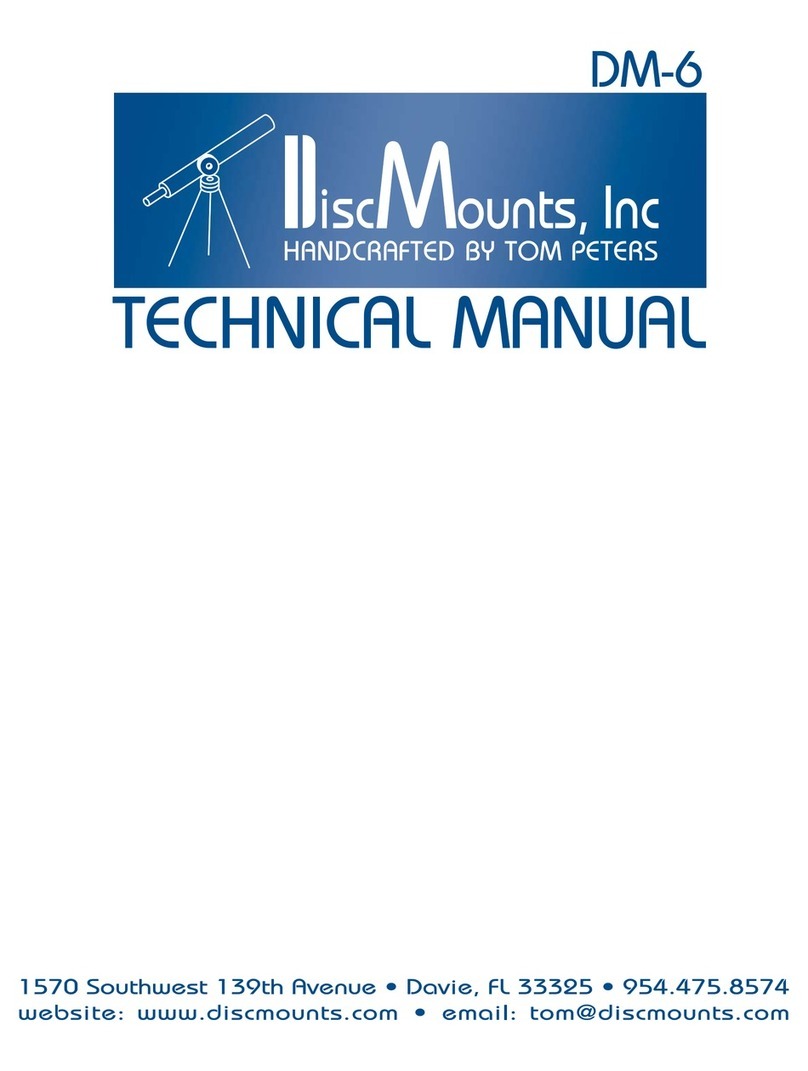
DiscMounts
DiscMounts Alt-Azimuth DM-6 Techical manual

Bresser
Bresser SKYLUX 60/700 AZ instruction manual
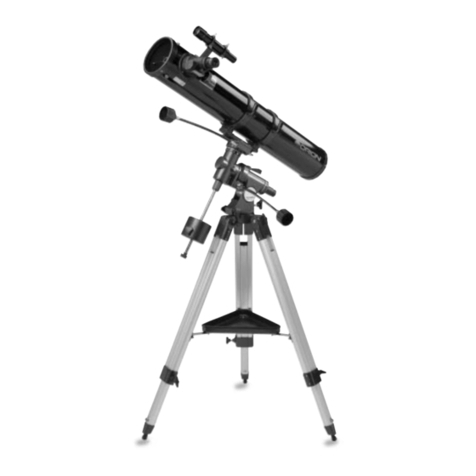
ORION TELESCOPES & BINOCULARS
ORION TELESCOPES & BINOCULARS SkyView Deluxe 4.5 EQ 9402 instruction manual
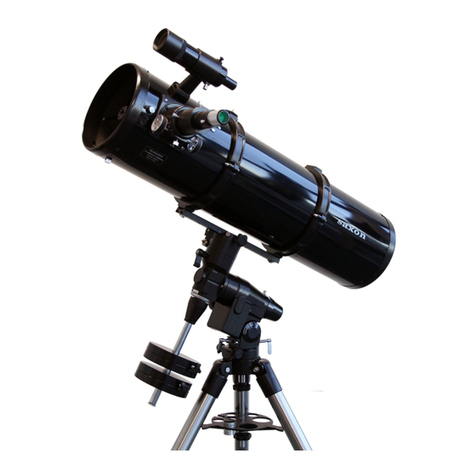
Saxon
Saxon 2001EQ5 instruction manual
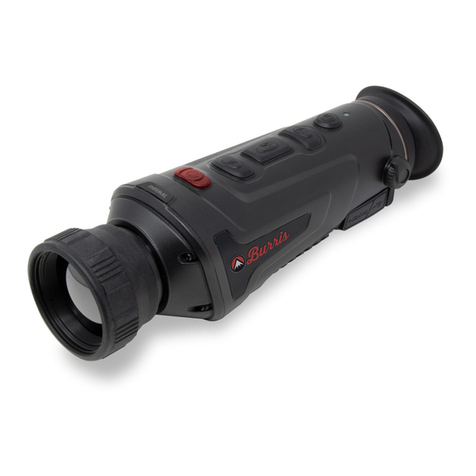
Burris
Burris BTH 25 user manual
